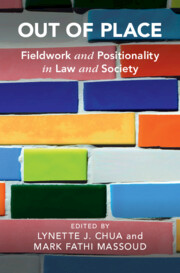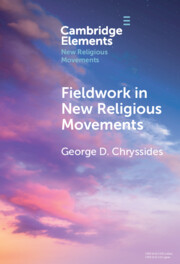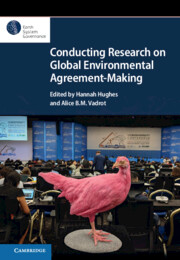69 results
5 - The Fieldwork and Its Findings
-
- Book:
- Improving Procedural Justice in Anti-Dumping Investigations
- Published online:
- 09 May 2024
- Print publication:
- 16 May 2024, pp 153-190
-
- Chapter
- Export citation
Chapter Seven - At Odds with Everything around Me
-
-
- Book:
- Out of Place
- Published online:
- 11 March 2024
- Print publication:
- 22 February 2024, pp 139-159
-
- Chapter
-
- You have access
- Open access
- HTML
- Export citation
Chapter Five - Feeling at Home Outside
-
-
- Book:
- Out of Place
- Published online:
- 11 March 2024
- Print publication:
- 22 February 2024, pp 103-118
-
- Chapter
-
- You have access
- Open access
- HTML
- Export citation
Chapter Two - Research as Accompaniment
-
-
- Book:
- Out of Place
- Published online:
- 11 March 2024
- Print publication:
- 22 February 2024, pp 36-56
-
- Chapter
-
- You have access
- Open access
- HTML
- Export citation

Out of Place
- Fieldwork and Positionality in Law and Society
-
- Published online:
- 11 March 2024
- Print publication:
- 22 February 2024
-
- Book
-
- You have access
- Open access
- Export citation
Preface
-
- Book:
- Out of Place
- Published online:
- 11 March 2024
- Print publication:
- 22 February 2024, pp xiii-xvi
-
- Chapter
-
- You have access
- Open access
- HTML
- Export citation
Chapter Four - Out of Place when Studying China’s Sex Industry
-
-
- Book:
- Out of Place
- Published online:
- 11 March 2024
- Print publication:
- 22 February 2024, pp 84-102
-
- Chapter
-
- You have access
- Open access
- HTML
- Export citation
Chapter Nine - Becoming a Familiar Outsider
-
-
- Book:
- Out of Place
- Published online:
- 11 March 2024
- Print publication:
- 22 February 2024, pp 188-208
-
- Chapter
-
- You have access
- Open access
- HTML
- Export citation
Chapter Six - Out of Place in an Indian Court
-
-
- Book:
- Out of Place
- Published online:
- 11 March 2024
- Print publication:
- 22 February 2024, pp 119-138
-
- Chapter
-
- You have access
- Open access
- HTML
- Export citation
Chapter Three - “Pretty and Young” in Places where People Get Killed in Broad Daylight
-
-
- Book:
- Out of Place
- Published online:
- 11 March 2024
- Print publication:
- 22 February 2024, pp 57-83
-
- Chapter
-
- You have access
- Open access
- HTML
- Export citation
Chapter One - Introduction
-
-
- Book:
- Out of Place
- Published online:
- 11 March 2024
- Print publication:
- 22 February 2024, pp 1-35
-
- Chapter
-
- You have access
- Open access
- HTML
- Export citation
Chapter Eight - Trigueño International Law
-
-
- Book:
- Out of Place
- Published online:
- 11 March 2024
- Print publication:
- 22 February 2024, pp 160-187
-
- Chapter
-
- You have access
- Open access
- HTML
- Export citation
Conclusion:
- from Part III - Interpreting
-
-
- Book:
- The Cambridge Guide to Mixed Methods Research for Theatre and Performance Studies
- Published online:
- 01 February 2024
- Print publication:
- 08 February 2024, pp 300-320
-
- Chapter
- Export citation
Chapter 10 - Fieldwork as Method in Theatre and Performance Studies
- from Part II - Doing
-
-
- Book:
- The Cambridge Guide to Mixed Methods Research for Theatre and Performance Studies
- Published online:
- 01 February 2024
- Print publication:
- 08 February 2024, pp 190-212
-
- Chapter
- Export citation
7 - Qualitative Fieldwork
- from Part I - Methods of Comparative Law
-
-
- Book:
- The Cambridge Handbook of Comparative Law
- Published online:
- 26 January 2024
- Print publication:
- 01 February 2024, pp 113-132
-
- Chapter
- Export citation

Fieldwork in New Religious Movements
-
- Published online:
- 20 December 2023
- Print publication:
- 22 February 2024
-
- Element
- Export citation
The challenges of fieldwork: Improving the experience for women in coastal sciences
-
- Journal:
- Cambridge Prisms: Coastal Futures / Volume 1 / 2023
- Published online by Cambridge University Press:
- 19 September 2023, e38
-
- Article
-
- You have access
- Open access
- HTML
- Export citation
15 - Conclusions
- from Part IV - Implementing and Adapting
-
-
- Book:
- Conducting Research on Global Environmental Agreement-Making
- Published online:
- 07 August 2023
- Print publication:
- 10 August 2023, pp 285-300
-
- Chapter
- Export citation

Conducting Research on Global Environmental Agreement-Making
-
- Published online:
- 07 August 2023
- Print publication:
- 10 August 2023
8 - Researching Linguistic Landscapes
-
- Book:
- Linguistic Landscapes
- Published online:
- 08 June 2023
- Print publication:
- 22 June 2023, pp 247-302
-
- Chapter
- Export citation



